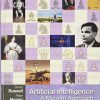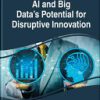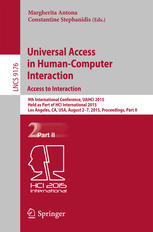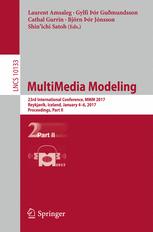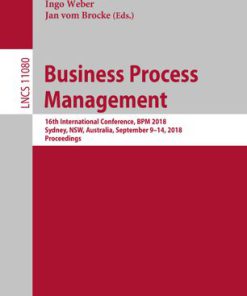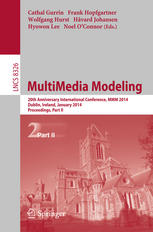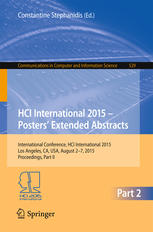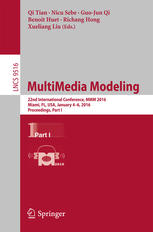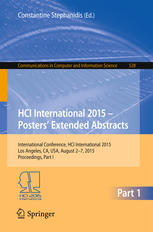MultiMedia Modeling 21st International Conference MMM 2015 Sydney NSW Australia January 5 7 2015 Proceedings Part II 1st Edition by Xiangjian He, Suhuai Luo, Dacheng Tao, Changsheng Xu, Jie Yang, Muhammad Abul Hasan ISBN 9783319144429 3319144421
$50.00 Original price was: $50.00.$25.00Current price is: $25.00.
MultiMedia Modeling 21st International Conference MMM 2015 Sydney NSW Australia January 5 7 2015 Proceedings Part II 1st Edition by Xiangjian He, Suhuai Luo, Dacheng Tao, Changsheng Xu, Jie Yang, Muhammad Abul Hasan – Ebook PDF Instant Download/Delivery: 9783319144429 ,3319144421
Full download MultiMedia Modeling 21st International Conference MMM 2015 Sydney NSW Australia January 5 7 2015 Proceedings Part II 1st Edition after payment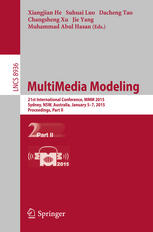
Product details:
ISBN 10: 3319144421
ISBN 13: 9783319144429
Author: Xiangjian He, Suhuai Luo, Dacheng Tao, Changsheng Xu, Jie Yang, Muhammad Abul Hasan
MultiMedia Modeling 21st International Conference MMM 2015 Sydney NSW Australia January 5 7 2015 Proceedings Part II 1st Edition Table of contents:
A Proxemic Multimedia Interaction over the Internet of Things
1 Introduction
2 Related Work
3 Proposed System
3.1 Devices
3.2 User Survey
3.3 Multimedia Content
3.4 Scoring Mechanism
3.5 Adaptation Mechanism
4 Evaluation
5 Discussion
6 Conclusion and Future Work
References
Outdoor Air Quality Inference from Single Image
1 Introduction
2 Feature Extraction
2.1 Medium Transmission
2.2 Power Spectrum Slope
2.3 Contrast
2.4 Normalized Saturation
3 Air Quality Inference
3.1 AQI Decision Tree
3.2 SVM Based Node Choice
4 Experiments and Analysis
4.1 Dataset
4.2 Ground Truth
4.3 Experimental Results
4.4 Efficiency
5 Conclusion
References
Multimodal Music Mood Classification by Fusion of Audio and Lyrics
1 Introduction
2 Text Features from Lyric
2.1 Distributed Representation of Word
2.2 Feature Extraction with Semi-supervised Recursive Autoencoder
2.3 Lyric Pre-filtering
3 Audio Features
4 Fusion and Classification
4.1 Hough Forest Classification Model
4.2 Feature-Level Fusion
4.3 Model-Level Fusion
5 Dataset
6 Results
7 Conclusion
References
Multidimensional Context Awareness in Mobile Devices
1 Introduction
2 Related Works
3 Multidimensional Context Aware Model
3.1 Who, When and How Verification
3.2 Where: Physical Location Recognition
3.3 What
4 Context Aware Access Control
4.1 MContext Aware RBAC Model
4.2 Prototype Implementation of MCRBAC
5 Experiments and Performance Analysis
5.1 Experiments
5.2 Performance Analysis
6 Conclusions
References
AttRel: An Approach to Person Re-Identification by Exploiting Attribute Relationships
1 Introduction
2 Related Work
3 AttRel: Exploiting Attribute Relationships
3.1 Attribute Relationship
3.2 Learning Attribute Relationships
3.3 Using Attribute Relationships
4 Experiments
4.1 Implementation Details
4.2 Results and Discussions
5 Conclusions
References
Sparsity-Based Occlusion Handling Method for Person Re-identification
1 Introduction
2 Approach
2.1 Patch-Based Matching Method
2.2 Sparsity-Based Occlusion Handling
2.3 Occlusion-Weighted Patch Matching
3 Experiments
3.1 Datasets and Experimental Settings
3.2 Results and Analysis
4 Conclusion
References
Visual Attention Driven by Auditory Cues
1 Introduction
2 Related Work
3 Proposed Model
3.1 Framework
3.2 Bayesian Surprise Model
3.3 Synchronization Detector
3.4 Features Selection
4 Experiments
5 Concluding Remarks
References
A Synchronization Ground Truth for the Jiku Mobile Video Dataset
1 Introduction
2 Related Work
3 Jiku Mobile Video Dataset
4 Methodology
4.1 Time Drift Correction
4.2 Manual Synchronization
5 Synchronization Ground Truth
5.1 Accuracy
5.2 Comparison
5.3 Evaluation
6 Conclusion
References
Mobile Image Analysis: Android vs. iOS
1 Introduction
2 Related Work
3 Goals and Measurements Setup
4 Results and Discussion
4.1 Common OpenCV Operations
4.2 Keypoint Detection/Descriptor Extraction
5 Conclusion
References
Dynamic User Authentication Based on Mouse Movements Curves
1 Introduction
2 Related Work
3 Behavior Modeling
4 Mouse Curve Features
4.1 Efficiency
4.2 Straightness
4.3 Regularity
4.4 Self-intersection
4.5 Curvature-Based Features
5 Behavior Comparison
6 Evaluation
7 Conclusions
References
Sliders Versus Storyboards – Investigating Interaction Design for Mobile Video Browsing
1 Introduction
2 Related Work
3 Interface Designs
4 Comparative Study
4.1 Study Design
4.2 Results
4.3 Discussion
5 Conclusions and Future Work
References
Performance Evaluation of Students Using Multimodal Learning Systems
1 Introduction
2 Related Work
3 System Model
3.1 Algorithm for Processing Student Data
4 Extraction of Annotation Information
4.1 Annotation Position
4.2 Annotation Text
4.3 Annotation System Choice
5 Fuzzy Membership Functions
5.1 Membership Function for Position
5.2 Membership Function for Text
5.3 Membership Function for System Choice
6 Multicriteria Decision Making Framework
7 Experimental Results
8 Conclusions
References
Is Your First Impression Reliable? Trustworthy Analysis Using Facial Traits in Portraits
1 Introduction
2 Methods
2.1 Facial traits
2.2 Features
3 Experiments
3.1 Dataset
3.2 Experiments and Discussions
4 Conclusions
References
Wifbs: A Web-Based Image Feature Benchmark System
1 Introduction
2 Related Work
3 System Benefits
4 System Overview
4.1 Administrators View
5 Implementation
5.1 Configurable Tools
5.2 Parametrization and Data Handling
5.3 System Execution
6 Usage
7 Conclusion
References
Personality Modeling Based Image Recommendation
1 Introduction
2 Enhancing Personality Modeling
2.1 Adding Semantic Features
2.2 Looking Beyond Existing Approaches
2.3 Expert vs. Self-assessed Profile
3 Experiments
3.1 The PsychoFlickr Dataset
3.2 Comparing Modeling Approaches
3.3 Expert vs. Self-assessed
3.4 Image Recommendation System
4 Conclusions
References
Aesthetic QR Codes Based on Two-Stage Image Blending
1 Introduction
2 Basic Characteristics of QR Code
3 Method for Two-Stage Image Blending
3.1 Overview
3.2 Stage 1: Module-Based Blending
3.3 Stage 2: Pixel-Based Blending
4 Experimental Results
4.1 Experiments on Readability
4.2 Subjective Evaluation
5 Conclusion
References
Person Re-identification Using Data-Driven Metric Adaptation
1 Introduction
2 The Approach
2.1 Cross-View Support Consistency
2.2 Cross-View Projection Consistency
3 Experiments
3.1 VIPeR Data Set
3.2 CUHK Data Set
3.3 Comparing to The-State-of-the-Art Person Re-id Methods
4 Conclusion
References
A Novel Optimized Watermark Embedding Scheme for Digital Images
1 Introduction
2 Introduction to DWT
3 Introduction to Artificial Bee Colony Algorithm
4 The Proposed New Embedding Algorithm
5 Experimental Results
5.1 The Proposed ABC Embedding and Extraction Algorithms
5.2 ABC Embedding and Extraction on Level 2 DWT
6 Conclusion
References
User-Centred Evaluation to Interface Design of E-Books
1 Introduction
2 Method
3 Results and Discussion
3.1 Quantitative Analysis (Operation Time and Error Frequency)
3.2 Qualitative Analysis (Subjective Satisfaction and Recommendations)
4 Conclusion
References
A New Image Decomposition and Reconstruction Approach — Adaptive Fourier Decomposition
1 Introduction
2 Principles of AFD Based Image Decomposition and Reconstruction Approach
2.1 Brief Overview of AFD
2.2 Decomposition Comparison between AFD and FT
2.3 The Algorithm of the Proposed Approach
3 Experimental Results
3.1 Experiments with Grayscale Images
3.2 Experiments with Color Images
4 Conclusions
References
Video Showcase
Graph-Based Browsing for Large Video Collections
1 Introduction
2 Building a Graph for Large Video Collections
3 Graph Visualization and Navigation
4 Using the Graph-Based Video Browser
References
Enhanced Signature-Based Video Browser
1 Introduction
2 Preprocessing
3 Enhanced Filtering
4 Enhanced Browsing
5 Conclusion
References
VERGE: A Multimodal Interactive Video Search Engine
1 Introduction
2 Video Retrieval System
2.1 Shot Segmentation
2.2 Scene Segmentation
2.3 Visual Similarity Search
2.4 High Level Concepts Retrieval Module
2.5 Hierarchical Clustering
3 VERGE Interface and Interaction Modes
4 Future Work
References
IMOTION — A Content-Based Video Retrieval Engine
1 Introduction
2 IMOTION System Architecture
3 Image and Motion Features
3.1 Low-Level Features
3.2 High-Level Features
4 Retrieval Modes
5 Conclusion
References
A Storyboard-Based Interface for Mobile Video Browsing
1 Introduction
2 Interface Designs
References
Collaborative Browsing and Search in Video Archives with Mobile Clients
1 Introduction
2 System Architecture
2.1 Server
2.2 Mobile Clients
3 Conclusion
References
The Multi-stripe Video Browser for Tablets
1 Introduction
2 Related Work
3 The Interface
3.1 Detail Mode
3.2 Overview Mode
4 Conclusions
References
NII-UIT Browser: A Multimodal Video Search System
1 Introduction
2 System Overview
2.1 User Interface
2.2 Off-line Processing
2.3 Online Process
3 Conclusion
References
Interactive Known-Item Search Using Semantic Textual and Colour Modalities
1 Introduction
2 Retrieval Modalities
2.1 Keyword-Based Retrieval
2.2 Color-Based Retrieval
2.3 Human Face Filtering
3 System Interactive Interface
4 Conclusion
References
Demonstration
ImageMap – Visually Browsing Millions of Images
1 Introduction
2 Related Work
3 Method
4 Experiments and Conclusion
References
Dynamic Hierarchical Visualization of Keyframes in Endoscopic Video
Introduction
Keyframe Extraction and Hierarchical Visualization
Dynamic Browsing of Clustered Keyframes
Conclusions
References
Facial Aging Simulator by Data-Driven Component-Based Texture Cloning
1 Introduction
2 Personality-Keeping Aging Dynamics
3 Natural Image Synthesis by Texture Cloning
4 Results and Future Works
References
Affective Music Recommendation from Video
1 Introduction
2 Proposed System
2.1 Setting an Input Video
2.2 Setting the User’s Music
2.3 Recommendation
3 Evaluation
4 Conclusion
References
MemLog, an Enhanced Lifelog Annotation and Search Tool
1 Introduction
2 Background
3 MemLog Overview
3.1 Evaluation of Memlog
4 Conclusion
References
Software Solution for HEVC Encoding and Decoding
1 Introduction
2 Implementation, Optimization and Performance
2.1 The Encoder
2.2 The Decoder
3 System Integration and Demonstration
4 Conclusion
References
A Surveillance Video Index and Browsing System Based on Object Flags and Video Synopsis
1 Introduction
2 Algorithms for Video Index and Browsing
3 System Demonstration
References
A Web Portal for Effective Multi-model Exploration
1 Introduction
2 Multi-model Approaches
2.1 Distance Weighting
2.2 Result Mixing
3 Conclusions
References
Wearable Cameras for Real-Time Activity Annotation
1 Introduction
2 The Platform
2.1 Interesting Event Detection
3 Conclusions
References
Personal (Big) Data Modeling for InformationAccess & Retrieval
Making Lifelogging Usable: Design Guidelines for Activity Trackers
1 Introduction
2 Related Work
3 Activity Trackers
4 Study Design
5 Study Results
5.1 Quantitative Results
5.2 Qualitative Results
6 Guidelines for the Design of Activity Trackers
7 Conclusion
References
Towards Consent-Based Lifelogging in Sport Analytic
1 Introduction
2 Lifelogging in Sports: A Use Case
3 Consent in Sport Analytic
4 Modeling Lifelogging for Privacy
4.1 Attribution of Data
4.2 Data Access
4.3 Bystanders
5 Discussions
6 Conclusions
References
A Multi-Dimensional Data Model for Personal Photo Browsing
1 Introduction
1.1 Background
1.2 Contributions
2 The M3 Data Model
2.1 Photo Description
2.2 Multi-Dimensional Aspects
2.3 Retrieval
3 Evaluation
3.1 Prototypes and Photo Collection
3.2 Detailed Browsing Scenario
3.3 Evaluation I: Advanced Users
3.4 Evaluation II: Novice Users
3.5 Facilitating Tagging
4 Related Work
5 Conclusion
References
Discriminative Regions: A Substrate for Analyzing Life-Logging Image Sequences
1 Introduction
2 Background
3 Consistent Regions
4 Discriminative Regions
5 Spatial Relations among Patches
6 Applications
7 Experiments and Results
7.1 Data Acquisition and Annotation
7.2 Implementation
7.3 Experiments
8 Conclusion
References
Fast Human Activity Recognition in Lifelogging
1 Introduction
2 Related Works
3 HAR Technique
3.1 Human Activities
3.2 Visual Data and Annotations
3.3 Visual Features
4 Evaluation
5 Results
6 Conclusion
References
Social Geo-Media Analytics and Retrieval
Iron Maiden While Jogging, Debussy for Dinner?
1 Introduction
2 Related Work
3 Data Acquisition
4 Predicting the User’s Music Taste
4.1 Individual Users
4.2 User Groups with Respect to Listening Activity
4.3 Feature Categories
5 Conclusion and Future Work
References
Travel Recommendation via Author Topic Model Based Collaborative Filtering
1 Introduction
2 Related Work
3 Offline Mining Module
3.1 City Level POIs Mining
3.2 User Travel History Mining
4 Online Recommendation
4.1 Author Topic Learning
4.2 POI Recommendation
5 Experimentation
5.1 Dataset
5.2 Performance Evaluation
5.3 Performance Comparison
5.4 Discussion
6 Conclusion
References
Robust Landmark Photo Retrieval
1 Introduction
2 Related Work
3 Approach
3.1 User Interest Based Community Discovery
3.2 Multiple Query Expansion and Pattern Mining
3.3 Landmark Photo Retrieval Rule
4 Experimental Studies
4.1 Datasets
4.2 Settings
4.3 Parameters Learning
4.4 Landmark Retrieval and Ranking
4.5 Comparing Query Expansion Approaches
5 Conclusion
References
Cross-Domain Concept Detection with Dictionary Coherence by Leveraging Web Images
1 Introduction
1.1 Related Work
2 Training Data Selection from Web
2.1 Sparse Coding and Dictionary Learning
2.2 Sampling from Web Images
2.3 Algorithm
2.4 Dictionary Learning
2.5 Dictionary Coherence Computing
2.6 Adaptive Sampling
3 Cross-Domain Video Concept Learning
4 Experiment
5 Conclusion
References
Semantic Correlation Mining between Images and Texts with Global Semantics and Local Mapping
1 Introduction
2 Our Framework
3 The Proposed Method
3.1 Image and Text Representation
3.2 Image-Text Correlation Computing
4 Experimental Results
4.1 Application of Image Tagging
4.2 Application of Cross-Media Retrieval
5 Conclusions
References
Image Taken Place Estimation via Geometric Constrained Spatial Layer Matching
1 Introduction
2 Related Work
3 System Overview
4 Refined Locations Generation
4.1 Grouping Images into Clusters
4.2 Cluster Location Estimation
5 Local Feature Refinement
5.1 Useful Features Selection
5.2 Spatial Layer Matching
6 Experimentation
6.1 Performance Evaluation
6.2 Performance Comparison
6.3 Discussion
7 Conclusion
References
Image or Video Processing, Semantic Analysis, andUnderstanding
Recognition of Meaningful Human Actions for Video Annotation Using EEG Based User Responses
1 Introduction
2 Materials and Methods
2.1 EEG Data Acquisition
2.2 EEG Feature Extraction
2.3 Classification
3 Experiment Results
4 Conclusion
References
Challenging Issues in Visual Information Understanding Researches
1 Introduction
2 Research Issues in Visual Data Understanding
2.1 Object Segmentation
2.2 Scene Understanding
2.3 Space Understanding and Context Awareness
2.4 Time Series Analysis of Scenes and a Space
3 Concluding Remarks
References
Emotional Tone-Based Audio Continuous Emotion Recognition
1 Introduction
2 Related Work
3 Emotional Tone-Based Two-Stage Algorithm
3.1 Overall Framework
3.2 Feature Extraction
3.3 Training Set Construction
3.4 GMM-HMM Classifier
4 Experiments
4.1 AVEC 2014 Dataset
4.2 Experimental Setup
4.3 Results
5 Conclusion
References
A Computationally Efficient Algorithm for Large Scale Near-Duplicate Video Detection
1 Introduction
2 Adaptive Locality Sensitive Hashing for SURF Indexing
2.1 Insights into SURF and LSH
2.2 Adaptive LSH (ADLSH) with Parameterizations
2.3 Descriptor Filtering (DF)
3 Two-Level Matching Scheme
4 Experiments
5 Conclusions and Future Work
References
Using CAD Techniques for 3D Object Extraction
1 Introduction
2 Related Work
3 Analysis
4 SLOREV Method
4.1 Sweeping
4.2 Lofting
4.3 Revolving
5 Results
6 Conclusions
References
Hessian Regularized Sparse Coding for Human Action Recognition
1 Introduction
2 Hessian Regularized Sparse Coding
3 Optimization of HessianSC
3.1 Learning Sparse Codes ô¢ with Fixe
3.2 Update Dictionary ô¡° with Fixe
4 Experiments
5 Conclusion
References
Robust Multi-label Image Classification with Semi-Supervised Learning and Active Learning
1 Introduction
2 Related Work
3 Multi-label Dimensionality Reduction via Non-negative Sparseness
3.1 Basics of Sparseness
3.2 NNS-DR
4 ML-SSAIC
4.1 Co-training
4.2 ML-SSAIC
5 Experiments and Analysis
5.1 Discriminative Capability of NNS-DR
5.2 Classification Performance
6 Conclusions
References
Photo Quality Assessment with DCNN that Understands Image Well
1 Introduction
2 Related Work
3 Features Extracted by the Deep Convolutional Neural Network
4 Experiments
4.1 Datasets
4.2 Experimental Settings
4.3 Experimental Results on the CUHKPQ
4.4 Experimental Results on the AVA
5 Conclusion
References
Non-negative Low-Rank and Group-Sparse Matrix Factorization
1 Introduction
2 Related Works
2.1 Non-negative Matrix Factorization
2.2 Low-Rank Representation
2.3 Group Sparse Coding
3 Non-negative Low-Rank and Group Sparse Matrix Factorization
3.1 The Proposed Model
3.2 Optimization Algorithm
4 Experiments
4.1 Face Clustering
4.2 Face Recognition
4.3 Parameter Selection
5 Conclusion
References
Two-Dimensional Euler PCA for Face Recognition
1 Introduction
2 Related Works
2.1 PCA
2.2 2DPCA
2.3 e-PCA
3 Two-dimensional Euler Principal Component Analysis
4 Experiments
4.1 Face Recognition
4.2 The Effect of
4.3 Time Evaluation
4.4 Robustness Evaluation
5 Conclusion
References
Multiclass Boosting Framework for Multimodal Data Analysis
1 Introduction
2 Risk Construction with Multiclass Loss Function
2.1 Multiclass Exponential Loss
2.2 Multiclass Logistic Loss
3 MMB Algorithm for Cross-Modal Retrieval
4 Experiments
4.1 Results on Wiki Dataset
4.2 Results on NUS-WIDE Dataset
5 Conclusions and Future Work
References
Author Index
People also search for MultiMedia Modeling 21st International Conference MMM 2015 Sydney NSW Australia January 5 7 2015 Proceedings Part II 1st Edition:
multimedia installations
multimedia contemporary design
21st century multimedia formats
interactive multimedia major
Tags:
Xiangjian He,Suhuai Luo,Dacheng Tao,Changsheng Xu,Jie Yang,Muhammad Abul Hasan,MultiMedia Modeling,21st International Conference
You may also like…
Science (General) - International Conferences and Symposiums
Computers - Computer Science
Computers - Computer Science
Computers - Computer Science
Computers - Computer Science


